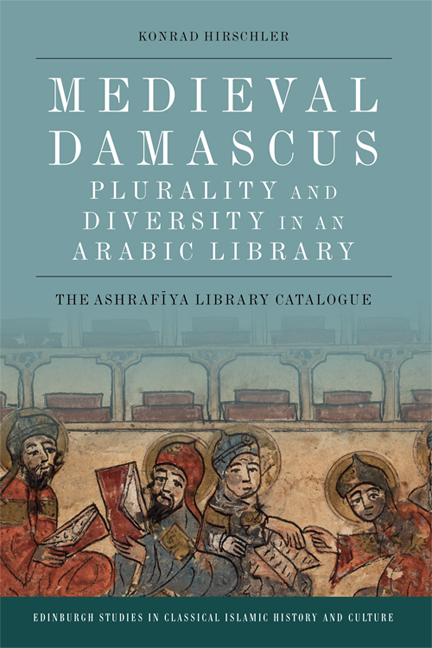Book contents
- Frontmatter
- Contents
- List of Illustrations
- Acknowledgements
- Introduction
- 1 The Making and Unmaking of a Medieval Library
- 2 Organising the Library: The Books on the Shelves
- 3 Plurality and Diversity: The Profile of a Medieval Library
- 4 The Ashrafīya Catalogue: Translation and Title Identification
- 5 The Ashrafīya Catalogue: Edition
- Bibliography
- Index of Subjects
- Index of Titles
- Index of Authors
- Index of External Categories
1 - The Making and Unmaking of a Medieval Library
Published online by Cambridge University Press: 05 August 2016
- Frontmatter
- Contents
- List of Illustrations
- Acknowledgements
- Introduction
- 1 The Making and Unmaking of a Medieval Library
- 2 Organising the Library: The Books on the Shelves
- 3 Plurality and Diversity: The Profile of a Medieval Library
- 4 The Ashrafīya Catalogue: Translation and Title Identification
- 5 The Ashrafīya Catalogue: Edition
- Bibliography
- Index of Subjects
- Index of Titles
- Index of Authors
- Index of External Categories
Summary
The Ayyubid period was one of extensive building activity during which many cities of Syria and Egypt were substantially redeveloped. Damascus was at the very centre of these activities and the city continually witnessed the erection of new edifices, especially educational institutions. The patrons of these ‘constructions of power and piety’ belonged mostly to the military and political elites. Al-Malik al-Ashraf was no exception and when he passed away in 635/1237 he had prominently inscribed himself into the urban texture of Damascus. His most visible legacy was two Dār al- aadīths, institutions dedicated to the study of the Prophetic tradition, which al-Malik al-Ashraf had built in the decade that he ruled the city. The inaugurations of the two institutions were important moments in the city's life and the buildings were to remain focal points of scholarly and devotional activities in the decades and centuries to come.
Their position within the urban landscape of Damascus was carefully chosen: Al-Ashraf built his first Dār al- hadīth intra muros and close to the citadel, the seat of military and political might in Damascus (number 164 in Map 1.1). Its significance went well beyond the scholarly and social elite as it housed a relic that al-Malik al-Ashraf had brought to Damascus, the Prophet's sandal. This sandal was a central element of the increasing Muaammad veneration that characterised the religious life of Damascus and Syria during this period. It remained for almost two centuries, until it was carried off by Tamerlane (Tīmūr (d. 807/1405)), one of the city's major attractions. Al-Malik al-Ashraf's second Dār al- hadīth was placed outside the city walls on the slope of Qāsyūn Mountain to the northwest of the city.
In the previous decades the Sālihīya suburb on Qāsyūn had witnessed rapid development and was a flourishing part of Damascus when he was ruling the city. Al-Malik al-Ashraf further deepened his devotional footprint by building or rebuilding several mosques across the city.
- Type
- Chapter
- Information
- Medieval Damascus: Plurality and Diversity in an Arabic LibraryThe Ashrafiya Library Catalogue, pp. 17 - 59Publisher: Edinburgh University PressPrint publication year: 2016



